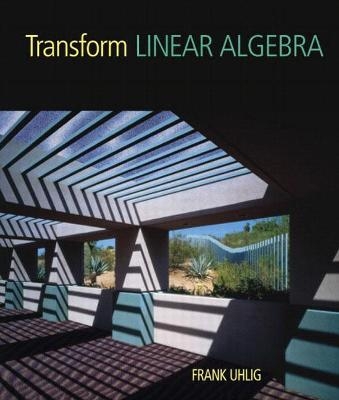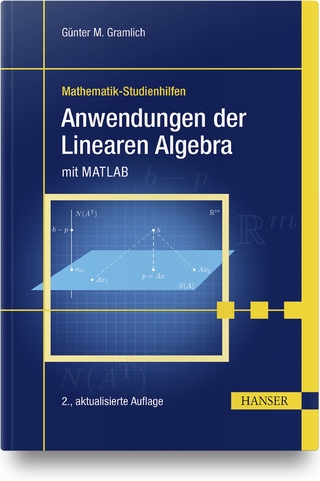
Transform Linear Algebra
Pearson (Verlag)
978-0-13-041535-6 (ISBN)
For the standard first course that emphasizes understanding some theory as well as computations for majors in economics, engineering, science, or mathematics. This text encourages students to develop an intuitive understanding of the foundations of Linear Algebra. An emphasis on the concepts of Linear Algebra and Matrix Theory conveys the structure and nature of Linear Spaces and of Linear Transformations. Almost every chapter has three sections: a lecture followed by problems, theoretical and mathematical enrichment, and applications to and from Linear Algebra. Overall, a transformations based text.
Frank Uhlig. Born April 2, 1945, Mägdesprung/Harz; grew up in Mülheim/Ruhr, Germany; married, two sons. Mathematics student at University of Cologne, California Institute of Technology. Ph.D., CalTech, 1972; Assistant, University of Würzburg, RWTH Aachen, Germany, 1972-1982. Two Habilitations (Mathematics), University of Würzburg 1977, RWTH Aachen 1978. Visiting Professor, Oregon State University 1979/1980; Professor of Mathematics, Auburn University 1982. Two Fulbright Grants; (Co-)organizer of eight research conferences. Research Areas: linear algebra, matrix theory, numerical analysis, numerical algebra, geometry, Krein spaces, graph theory, mechanics, inverse problems. 40+ papers, 2+ books.
(NOTE: * Available on Web only).
Introduction (Mathematical Preliminaries, Vectors, Sets, and Symbols).
1. Linear Transformations.
Lecture One: Vectors, Linear Functions, and Matrices. Tasks and Methods of Linear Algebra. Applications: Geometry, Calculus, and MATLAB.
2. Row-Reduction.
Lecture Two: Gaussian Elimination and the Echelon Forms. Applications: MATLAB.
3. Linear Equations.
Lecture Three: Solvability and Solutions of Linear Systems. Applications: Circuits, Networks, Chemistry, and MATLAB.
4. Subspaces.
Lecture Four: The Image and Kernel of a Linear Transformation. Applications: Join and Intersection of Subspaces.
5. Linear Dependence, Bases, and Dimension.
Lecture Five: Minimal Spanning or Maximally Independent Sets of Vectors. Applications: Multiple Spanning Sets of One Subspace, MATLAB.
6. Composition of Maps, Matrix Inverse.
Lecture Six. Theory: Gauss Elimination Matrix Products, the Uniqueness of the Inverse, and Block Matrix Products. Applications (MATLAB).
7. Coordinate Vectors, Basis Change.
Lecture Seven: Matrix Representations with Respect to General Bases. Theory: Rank, Matrix Transpose. Applications: Subspace Basis Change, Calculus.
8. Determinants, Lambda-Matrices.
Lecture Eight: Laplace Expansion, Gaussian Elimination, and Properties. Theory: Axiomatic Definition. Applications: Volume Wronskian.
9. Matrix Eigenvalues and Eigenvectors.
Lecture Nine, Using Vector Iteration: Vanishing and Minimal Polynomial, Matrix Eigenanalysis, and Diagonalizable Matrices. Lecture Nine, Using Determinants: Characteristic Polynomial, Matrix Eigenanalysis, and Diagonalizable Matrices. Theory: Geometry, Vector Iteration, and Eigenvalue Functions. Applications: Stochastic Matrices, Systems of Linear DE's and MATLAB.
10. Orthogonal Bases and Orthogonal Matrices.
Lecture Ten: Length, Orthogonality, and Orthonormal Bases. Theory: Matrix Generation, Rank 1 and Householder Matrices. Applications: QR Decomposition, MATLAB, and Least Squares.
11. Symmetric and Normal Matrix Eigenvalues.
Lecture Eleven: Matrix Representations with respect to One Orthonormal Basis. Theory: Normal Matrices. Applications: Polar Decomposition, Volume, ODEs, and Quadrics.
12. Singular Values.
Lecture Twelve: Matrix Representations w.r.t. Two Orthonormal Bases. Theory: Matrix Approximation, Least Squares. Applications: Geometry, Data Compression, Least Squares, and MATLAB.
13. Basic Numerical Linear Algebra Techniques.
Lecture Thirteen: Computer Arithmetic, Stability, and the QR Algorithm.
*14. Nondiagonalizable Matrices, the Jordan Normal Form.
Lecture Fourteen: (Jordan Normal Form). Theory: Real Jordan Normal Form, Companion Matrix. Applications: Linear Differential Equations, Positive Matrices.
Epilogue.
Appendix A (Complex Numbers and Vectors).
Appendix B (Finding Integer Roots of Integer Polynomials).
Appendix C (Abstract Vector Spaces).
*Appendix D (Inner Product Spaces).
Solutions.
Index.
List of Photographs.
| Erscheint lt. Verlag | 10.4.2002 |
|---|---|
| Sprache | englisch |
| Maße | 211 x 242 mm |
| Gewicht | 1069 g |
| Themenwelt | Mathematik / Informatik ► Mathematik ► Algebra |
| ISBN-10 | 0-13-041535-9 / 0130415359 |
| ISBN-13 | 978-0-13-041535-6 / 9780130415356 |
| Zustand | Neuware |
| Haben Sie eine Frage zum Produkt? |
aus dem Bereich


